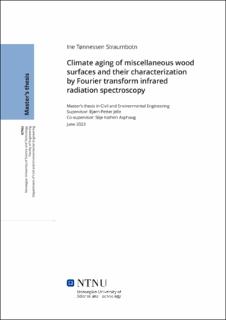| dc.contributor.advisor | Jelle, Bjørn Petter | |
| dc.contributor.advisor | Asphaug, Silje Kathrin | |
| dc.contributor.author | Straumbotn, Ine Tønnessen | |
| dc.date.accessioned | 2023-09-27T17:19:59Z | |
| dc.date.available | 2023-09-27T17:19:59Z | |
| dc.date.issued | 2023 | |
| dc.identifier | no.ntnu:inspera:142713575:34348318 | |
| dc.identifier.uri | https://hdl.handle.net/11250/3092498 | |
| dc.description.abstract | I følge klimamodellene til FNs klimapanel vil behovet for motstandsdyktige byggematerialer øke i tide fremover. Samtidig setter bærekraftsmålene krav til materialvalg, hvor motstandsdyktighet og holdbarhet må balanseres opp mot bærekraft. Under slike vurderinger er det derfor nødvendig å kjenne til holdbarheten til materialene, og dermed kunne sette riktig vedlikeholdsintervall for en lenger levetid.
I samarbeid med SINTEF og kledningsleverandør AG-Tre er holbarheten til diverse utvendige kledninger undersøkt: brent kledning, brent kledning med ultraviolet (UV) beis, grunnet og malt kledning og royalimpregnert kledning. Gjennom å påkjenne kledningsprøvene for naturlig og kunstig klimaaldring er det undersøkt hvilke nedbrytningsprosesser som finner sted ved hjelp av Fourier transform infrarød (FTIR) spektroskopi. Prøvene er i tillegg fotografert med et spesialisert kameraoppsett for å undersøke visuelle endringer.
Visuelt viste den akselererte klimaaldringen at brent kledning med og uten UV beis grånet. De resterende kledningene, royalimpregnert og grunnet og malt kledning, viste derimot en mye høyere fargestabilitet. Kjemisk, fra FTIR-analysen, var det små indikatorer på nedbrytning av lignin på fremsiden av alle kledningene, bortsett fra for grunnet og malt kledning. Derimot var det ingen klare indikasjoner på kjemiske endringer på innsiden relativt nær framsiden for noen av kledningene, noe som indikerer relativt motstandsdyktige trekledninger. Likevel, på grunn av flere mulige observerte usikkerheter knyttet til analyseprosessen, er det nødvendig med for eksempel lenger aldringstid for å undersøke utviklingen til de observerte resultatene.
Resultater fra prøvingen indikerer dermed at brent kledning ikke har noe betydelig dårligere kjemisk holdbarhet enn de andre undersøkte kledningene. Dette er positive resultater for brent kledning som et miljøvennlig alternativ til utvendig kledning, og gir nyttig informasjon som vil bli viktigere for å beskytte bygningene våre mot kommende klimaendringer og redusere klimautslipp. Det bør likevel nevnes at videre studier er nødvendig for å kunne si noe om den forventede levetiden og vedlikeholdsbehovet til denne typen kledning utover funnene som er gjort i denne oppgaven. Eksempler på videre studier kan være forlenget aldringstid, for de samme aldringstestene gjort i denne studien, og livssyklusanalyse for å kunne kvantifisere klimagassutslippene. | |
| dc.description.abstract | According to the climate models worked out by the Intergovernmental panel on climate change (IPCC), building materials requirement to resistance will increase. Simultaneously, the UN sustainable development goals set requirements to choices of building materials, where resistance and durability must be balanced against sustainability. Therefore, during such assessments, it is necessary to predict the durability of the materials, to be able to set the correct maintenance interval for a longer service life.
In collaboration with SINTEF and manufacturing enterprise AG-Tre, the durability of miscellaneous claddings has been examined: charred wood, charred wood with ultraviolet (UV) resistant stain, primed and painted wood, and royal-impregnated wood. By exposing the claddings to natural and artificial climate aging, it has been investigated which degradation mechanisms are taking place by using Fourier transform infrared (FTIR) spectroscopy. The claddings were also photographed with a specialized camera setup to examine visual changes.
The results show that visually, the artificial weathering left the samples of charred wood faded. However, a clear trend of higher color stability was visible in royal-impregnated and primed and painted wood. Chemically, from the FTIR analysis, indicators of lignin degradations appear at the front surface of the claddings, except for primed and painted wood. However, no clear indications of chemical changes were shown at the inside relatively close to the front surface, indicating relatively weather resistant wooden claddings. Nevertheless, due to several possible uncertainties observed in the analyze process, further investigations with e.g. longer aging time will be necessary to examine the developments of the observed results.
The results from the tests does not clearly indicate that charred wood is considerably less durable than the other examined claddings. This is positive results for charred wood as an eco-friendly alternative to exterior cladding and provide useful information that will become increasingly important to protect our buildings from the impacts of forthcoming climate changes and reduce greenhouse gases. Nevertheless, further work is necessary in order to possibly determine the expected service life and maintenance interval for charred wood beyond the findings that have arisen in this thesis. Examples of further work could be extended aging time, for the same weathering test carried out in this study, and life cycle assessment to quantify the emissions of greenhouse gases. | |
| dc.language | eng | |
| dc.publisher | NTNU | |
| dc.title | Climate aging of miscellaneous wood surfaces and their characterization by Fourier transform infrared radiation spectroscopy | |
| dc.type | Master thesis | |
